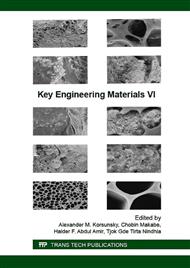[1]
B. S. Patil and K. S. Kulkarni, Development of high surface area activated carbon from waste material, International Journal of Advanced Engineering and Studies (IJAERS). 1 (2012) 109-113.
Google Scholar
[2]
F. O. Aramide, Simeon Ademola Ibitoye, I. O. Oladele, and J. O. Borode, Effects of carburization time and temperature on the mechanical properties of carburized mild steel, using activated carbon as carburizer, Materials Research. 12 (2009).
DOI: 10.1590/s1516-14392009000400018
Google Scholar
[3]
S. Mahanim, I. W. Asma, J. Rafidah, E. Puad, and H. Shaharuddin, Production of activated carbon from industrial bamboo waste, Journal of Tropical Forest Science. 23 (2011) 417-424.
Google Scholar
[4]
F. T. Ademiluyi and O. Braide, Effectiveness of Nigerian bamboo activated with different activating agents on the adsorption of BTX, J. Appl. Sci. Environ. Manage. 16 (2012) 267 - 273.
Google Scholar
[5]
W. H. Cheung, S. S. Y. Lau, S. Y. Leung, A. W. M. Ip, and G. McKay, Characteristics of chemical modified activated carbons from bamboo scaffolding, Chinese Journal of Chemical Engineering. 20 (2012) 515-523.
DOI: 10.1016/s1004-9541(11)60213-9
Google Scholar
[6]
A. O. Oyedun, K. -L. Lam, T. Gebreegziabher, H. K. M. Lee, and C. -W. Hui, Kinetic modelling and analysis of waste bamboo pyrolysis, Chemical Engineering Transactions. 29 (2012) 697-702.
Google Scholar
[7]
X. Gu, Y. Wang, C. lai, J. Qiu, S. Li, Y. L. Huo, W. Martens, N. Mahmood, and S. Zhang, Microporous bamboo biochar for litium - sulfur battery, Nano Research. (2014) 1-14.
DOI: 10.1007/s12274-014-0601-1
Google Scholar
[8]
X. Ma, H. Yang, L. Yu, Y. Chen, and Y. Li, Preparation, surface and pore structure of high surface area activated carbon fibers from bamboo by steam activation, Materials. 7 (2014) 4431- 4441.
DOI: 10.3390/ma7064431
Google Scholar
[9]
T. Huang, Z. Qiu, D. Wu, and Z. Hu, Bamboo-based activated carbon @ MnO2 nanocomposites for flexible high-performance supercapacitor electrode materials, Int. J. Electrochem. Sci. 10 (2015) 6312 - 6323.
DOI: 10.1016/s1452-3981(23)06721-4
Google Scholar
[10]
W. K. Koo, N. A. Gani, M. S. Shamsuddin, N. S. Subki, and M. A. Sulaiman, Comparison of wastewater treatment using activated carbon from bamboo and oil palm: an overview, Journal of Tropical and Resource Sustainable Science. 3 (2015) 54-60.
DOI: 10.47253/jtrss.v3i1.689
Google Scholar
[11]
K. K. H. Choy, J. P. Barford, and G. McKay, Production of activated carbon from bamboo scaffolding waste - process design, evaluation and sensitivity analysis, Chemical Engineering Journal. 109 (2005) 147–165.
DOI: 10.1016/j.cej.2005.02.030
Google Scholar
[12]
A. A. Awoyale, A. C. Eloka-Eboka, and O. A. Odubiyi, Production and experimental efficiency of activated carbon from local waste bamboo for waste water treatment, International Journal of Engineering and Applied Sciences. 3 (2013) 8-17.
Google Scholar
[13]
J. G, Akpa, and C.G. J, Nmegbu, Adsorption of benzene on activated carbon from agricultural waste Materials, Research Journal of Chemical Sciences. 4 (2014) 30-34.
Google Scholar
[14]
I. A. A. C. Esteves, M. S. S. Lopes, P. M. C. Nunes, and J. e. P. B. Mota, Adsorption of natural gas and biogas components on activated carbon, Separation and Purification Technology. 62 (2008) 281–296.
DOI: 10.1016/j.seppur.2008.01.027
Google Scholar
[15]
K. Inomata, K. Kanazawa, Y. Urabe, H. Hosono, and T. Araki, Natural gas storage in activated carbon pellets without a binder, Carbon. 40 (2002) 87-93.
DOI: 10.1016/s0008-6223(01)00084-7
Google Scholar
[16]
D. C. Azevedo, J. C. S. Araujo, M. Bastos-Neto, A. E. B. Torres, E. F. Jaguaribe, and C. L. Cavalcante, Microporous activated carbon prepared from coconut shells using chemical activation with zinc chloride, Microporous and Mesoporous Materials. 100 (2007).
DOI: 10.1016/j.micromeso.2006.11.024
Google Scholar
[17]
K. Ramakrishnan and C. Namasivayam, Development and characteristics of activated carbons from jatropha husk, an agro industrial solid waste, by chemical activation methods J. Environ. Eng. Manage. 19 (2009) 173-178.
Google Scholar
[18]
T. Zhang, W. P. Walawender, and L. Fan, Grain-based activated carbons for natural gas storage, Bioresource Technology. 101 (2010) 1983-(1991).
DOI: 10.1016/j.biortech.2009.10.046
Google Scholar
[19]
J. Sreńscek-Nazzal, W. Kamińska, B. Michalkiewicz, and Z. C. Koren, Production, characterization and methane storage potential of KOH-activated carbon from sugarcane molasses, Industrial Crops and Products. 47 (2013) 153-159.
DOI: 10.1016/j.indcrop.2013.03.004
Google Scholar
[20]
A. Rijali and U. Malik, Pembuatan dan karakterisasi karbon aktif dari bambu betung dengan aktivasi menggunakan activating agent H2O, JOM Bidang Matematika dan Ilmu Pengetahuan Alam. 2 (2015) 102-107.
DOI: 10.24036/p.v10i2.112417
Google Scholar
[21]
Q. -S. Liu, T. Zheng, P. Wang, and L. Guo, Preparation and characterization of activated carbon from bamboo by microwave-induced phosphoric acid activation, Industrial Crops and Products 31 (2010) 233–238.
DOI: 10.1016/j.indcrop.2009.10.011
Google Scholar
[22]
X. Ma, H. Yang, L. Yu, Y. Chen, and Y. Li, Preparation, surface and pore structure of high surface area activated carbon fibers from bamboo by steam activation, Materials. 7 (2014) 4431- 4441.
DOI: 10.3390/ma7064431
Google Scholar
[23]
D. Lozano-Castello, J. Alcan˜iz-Monge, M. A. d. l. Casa-Lillo, D. Cazorla-Amoro´s, and A. Linares-Solano, Advances in the study of methane storage in porous carbonaceous materials, Fuel. 81 (2002) 1777-1803.
DOI: 10.1016/s0016-2361(02)00124-2
Google Scholar
[24]
http: /drdiahkencana. wordpress. com.
Google Scholar


